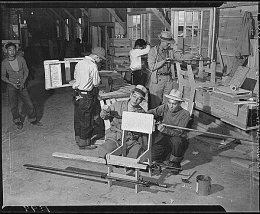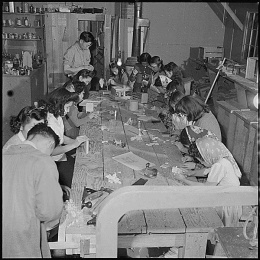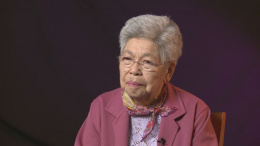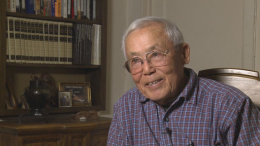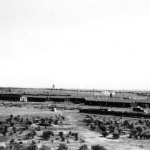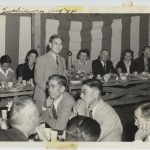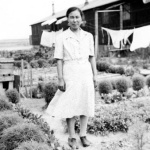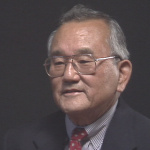Arts and crafts in camp
As a result of
Executive Order 9066
signed on 19 February 1942, by President
Franklin D. Roosevelt
, more than 120,000 persons of Japanese ancestry living in the U.S. were forced from their homes and imprisoned in concentration camps.
[1]
Stripped of their civil and political rights and confined in harsh landscapes, these new prisoners of the U.S. government quickly began creating art, broadly defined, that aided their efforts in re-territorializing the camps. Through this process of re-territorialization, imprisoned Japanese Americans altered shoddily built, crowded, and barren inside living areas into spaces of survival.
Furniture Making
Furniture making was the most immediate art activity of many detainees during the first days of imprisonment as they attempted to transform dilapidated barracks into adequate shelter. [2] For most detainees furniture building occurred twice, first at temporary imprisonment facilities euphemistically referred to by the government as "assembly centers" and then again, at one of the ten permanent concentration camps. Even though detainees recognized that their confinement in "assembly centers" would be short lived, they immediately began employing carpentry to create spaces of survival. Men were the most active participants in this art form with wood understood as a manly medium, but some women crossed gendered crafting lines to help furnish living units with camp-made tables, chairs, beds, shelves, desks, benches, partitions, and closets. [3]
At their permanent locations of incarceration, detainees again set to creating habitable places of survival by making furniture. Having devised adequate sleeping spaces, crafters shifted their attention to other types of furniture including privacy screens, nightstands, shelves, chairs, and tables. [4] Describing her family's living unit at Amache (Granada) as "nothing but a big room," Yoshie Mary Tashima's spirits were lifted by the appearance of furniture made by her brothers from scrap lumber. [5] Two brothers imprisoned at Topaz transformed the wooden crate that once protected their new potbelly stove into a five-foot long cushion-less couch. [6] Again countering the gendered image of furniture makers with the headline, "She Makes 'Em Herself," the Manzanar Free Press reported that Fumi Marumoto of Block 9 created a small bench and a "closet of shelves" from a discarded orange crate and cardboard boxes. [7] As a Minidoka detainee remembered, the idea of "comfort" remained uppermost in the minds of Japanese Americans as they again re- positioned themselves in harsh places of imprisonment by creating furniture from found materials. [8]
Reacting to a desperate need for privacy, detainees constructed carefully crafted screens and partitions from scrap wood, spare blankets, and cloth. Some detainees extended walls of individual living units to the ceiling while others partitioned their already small rooms into sleeping and living areas. [9] While attending an art exhibit at Tulare , an Issei woman admired a privacy screen noting in a diary entry that the art form was made by meticulously piecing together small pieces of scrap wood. [10] At Tule Lake , administration officials reacted negatively to repeated requests from detainees for partition making supplies. But when new barracks were constructed to house detainees transferred from temporary imprisonment facilities and supposed troublemakers from other concentration camps, detainees already imprisoned at Tule Lake lost little time taking advantage of new supply piles at the camp lumberyard. As one detainee reported "our luck changed" and "we band[ed] together to attack in groups." [11] One Tule Lake detainee recalled that these camp-made screens made her family's "barren room look a bit more homey." [12]
Supplies for making furniture were difficult to come by and proved to be the most significant obstacle for furniture makers. Furniture makers dug through soil surrounding newly constructed barracks for discarded nails, while others hiked throughout the camps looking for scraps of lumber, discarded fruit crates, and cardboard boxes. [13] Persistent and enduring shortages of furniture making supplies prompted many detainees, primarily men, to take War Relocation Authority carpentry jobs. By securing these positions, camp carpenters established easier access to nails and wood for building chairs, benches, tables, and other "knick-knacks" that made living units more livable. [14] Understanding nails as prized possessions is likely difficult for many readers, but for imprisoned Japanese Americans, furniture building materials were considered extraordinarily generous gifts. A woman imprisoned at Gila River remembered giving nails, many of them bent, as an engagement gift to her friend. Gathered by sifting through sand in a windbreak area where scrap lumber was piled and raiding her father's supply, the "precious" nails were wrapped in paper that previously lined fruit crates. [15]
Transforming Living Units
Furniture making was only one art form used by detainees to transform their living units into places of survival. With the very basic and immediate needs for beds and furniture met, women reacted to oppressive living conditions in "assembly centers" and concentration camps by crocheting, sewing, weaving, embroidering, and knitting. Colorful and intricately crocheted blankets, table cloths, teapot holders, and pillow cases were popular and welcomed additions to drab surroundings. Needle crafters creating decorative art for living units often worked together sharing techniques and ideas. Women imprisoned in Tanforan created "house-step sewing circles," where they made a wide range of items from yarn and fabric including table runners, slipcovers, lamp shades, bedspreads, afghans, and quilts.
At Rohwer an old loom requiring repairs sat unused for several months, but a newly hired staff person with weaving skills was eager to restore the device to working condition. Soon Japanese American women were unraveling burlap sacks retrieved from camp warehouses, washing and coloring the "yarn" with vegetable dyes, then weaving the material into rugs. Others artists gathered flat slender sticks, weaving them into Venetian-like blinds for windows, and when bundles of clothes were donated to the camp, detainees cut them into strips creating more than seven hundred rag rugs for the floors of living units. [16] Free patterns for pandas and giraffes standing one foot high were provided by the "Women's Mirror" editor of the camp newspaper who informed her readers that these bed or shelf decorations were easily made for ten cents worth of materials and doubled as toys for children. [17] Another Topaz woman solved a persistent cold weather problem by crocheting woolen covers that prevented her family's hands from adhering to frigid metal door knobs. According to her seventeen year old daughter, losing a piece of flesh while opening doors was a frequent and painful experience prior to her mother's invention. [18] Such practical additions to living quarters were carefully created to brighten austere interior surroundings.
Artificial flowers were also frequent additions making living quarters more hospitable. Careful to save colorful pages from catalogs and magazines, women transformed the paper into flowers and then sewed them onto muslin covered balls stuffed with wadded paper, sewing scraps, or discarded bedding materials. Measuring approximately six inches in diameter, these artificial flower arrangements were hung from ceilings and walls of living units. Other women created similarly flowered art forms from silk scraps. [19] Women imprisoned at Poston made artificial chrysanthemums, gardenias, irises, sweetpeas, cherry blossoms, lilacs, and carnations from colored paper that once lined apple and orange crates. Miwako Oano described her friend's flowers as "so beautiful and so realistic that when I come home every day, my first impulse is to inhale the sweet fragrance one would expect to find emanating from such loveliness." [20]
Ikebana was an important art form in all ten concentration camps, lining shelves and resting on tables in the living quarters of detainees. At risk of over simplifying this complex and deeply theoretical art form, ikebana is grounded in the belief that the lives of flowers and the lives of humans are inseparable, with the style, size, shape, texture, and color of both arrangements and containers carrying great meaning. In addition to using empty space to communicate ideas, ikebana artists attach significance to the location of arrangements and the occasions for which they are created. Along with flowers, a great diversity of materials are used including, but not limited to: branches, vines, leaves, grasses, berries, fruit, seeds, and dried or wilted plants, each conveying meaning of their own. Imprisoned Japanese Americans demonstrated great skill adapting traditional forms of ikebana to their concentration camp landscapes. [21]
Wood panels featuring carved images and decorated with flowers made from shells and crepe paper were common adornments on barracks walls. Shells were gathered from the ancient and massive Pleistocene lake beds that made up the landscapes of Topaz and Tule Lake and then mailed to friends and families incarcerated in other camps as craft making supplies. [22] One such panel created at Tule Lake depicted intricate plum blossoms made from shells. Sitting on a papier-mâché branch was a small painted bird carved from wood. [23] Detainees carved, polished, and filed wood and stones found in the areas surrounding the camps into striking sculptures that rested on shelves and tables. [24]
Kobu was an art form created in most imprisonment locations, but especially popular in the Arkansas camps. With an abundance of recently felled trees, detainees imprisoned at Rohwer and Jerome decorated their living units with natural formations found in the roots of elm, hickory, and oak trees. Carefully stripping away decayed pieces of wood and bark by boiling roots and tree trunks, detainees revealed raw sculptures which were oiled, polished, and finally varnished to a high gleam. [25] Some of these artists were purists only slightly altering figures shaped naturally, while others took a more aggressive approach carving and hollowing out such items as match holders, bowls, and plaques from slabs of tree trunks. Among the natural forms were monkeys, lizards, birds, and human figures. What detainees referred to as "cypress knees" was also valued by kobu artists often providing pieces of wood that were easily hollowed into vases. Exceptionally prized and rare, these works of art were used as vessels for flower arrangements by ikebana enthusiasts. [26]
A primary obstacle for most imprisoned crafters was overcoming persistent shortages of art making supplies, but two materials commonly used in their art form, sand and dirt surrounded bon-kei enthusiasts. Perhaps best translated as "landscape in a tray," bon-kei reproduced in miniature all elements of a specific landscape including buildings and people. Having been exposed to this art form during her childhood in Japan, Mrs. Ninomiya looked out on Amache's dusty landscape and saw possibilities that eluded most detainees. Having completed an example of bon-kei during her first days of imprisonment, Ninomiya soon found herself with ninety-two students, none of whom had previous experience with the art form. Tray making materials presented the biggest obstacle with Ninomiya's pupils, always on the outlook for discarded vegetable crates, but unfortunately demand far exceeded supply. Detainees started a letter writing campaign sending friends back home off on tray shopping expeditions that included final stops at the post office. Receiving tray making materials in the mail, detainees at Amache created mountain, desert, seacoast, and "imaginary Japanese" scenes. Bon kei decorated many of Amache's living units with detainees mulling over the irony of making art from a material they so often cursed. [27]
Free standing wood sculptures were carved by detainees and placed on tables and shelves located in living units while embroidered landscapes decorated rough barracks walls. Art works created by imprisoned children were welcomed additions to living unit decor with drawings and paintings covering entire sections of some walls. Detainees marked holidays by creating special pieces of art as in the case of one teenager. Hoping to brighten the mood of his family's first Christmas at Tule Lake, this high school aged boy spent his monthly clothing allowance check of three dollars and fifty cents purchasing several packages of construction paper. After transforming green paper and glue into a one foot tall Christmas tree, he created ornaments by cutting small circles from sheets of red, yellow, pink, and orange paper. Once these decorations were pasted on the tree, the family of this Nisei artist admitted that the camp-made Christmas tree helped lift the "dark clouds" hanging over their lives. [28]
In their efforts to create physical comfort, detainees laid the groundwork for remaking mental and physical landscapes of survival by using art to decorate their living quarters. Stripped of their personal possessions, detainees demonstrated their commitment to survival by inhabiting their living units with art in the form of kobu , wood-carvings, ikebana , embroidered wall hangings, and paper flowers. Camp-made crafts articulated fluid, shifting, and multiple stances against oppressive living conditions. By filling their living units with art, detainees made their surroundings look and feel less like spaces of incarceration, an important consideration for parents who struggled to establish even limited amounts of normalcy for their children. Through and with art, detainees spoke loudly voicing commitments to survival by improving their material lots in life and remaking both physical and mental landscapes. In this way art aided detainees in developing understandings of themselves as agents of their own lives. By remaking inside places of imprisonment, detainees identified with each other on the basis of survival and comfort.
Exhibitions and Classes
Many detainees sustained and created new bonds among themselves by exhibiting their artwork. Serving as webs of collectivities, the exhibits best demonstrated the diversity of art created by imprisoned Japanese Americans. In these display spaces, they gathered to participate in complicated, colorful, and rich visual conversations that revealed inhuman treatments, economic exploitations, and dislocations encompassed by Executive Order 9066. Displaying wide variations in terms of interests, form, materials used, and expressive style, these works of art provoked ideas, resistive practices, and strategies for improving both physical and mental conditions. Here, detainees connected and formed attachments with the purpose of improving their lots in life. Embedded in these artifacts were subversions, with detainees speaking about the control exerted on their lives. For people confined in barren and monochromatic environments, art shows also offered counter landscapes, adding vibrancy and color to camp palates dominated by shades of tan.
Classes were more monolithic in size and duration than exhibits, but just as varied in terms of art form, training of the teachers, and skill of students. Like exhibits, classes created connections between people of diverse backgrounds and interests serving as webs of collectivities where detainees developed new attachments and created art that sustained already established relationships. Attempts by detainees to organize classes were not always welcomed by camp officials. Some art classes were taught by professional artists. Three days after arriving at Tanforan, Chiura Obata, a professor of art at the University of California, Berkeley, approached administrators hoping to obtain space for an art school. While camp officials were initially hesitant to grant such a request, coaxing on the part of detainees was successful with the Tanforan Art School opening on May 25 at the former location of Mess Hall 6. Supplies were provided by friends, students from the university, and the American Friends Services Committee, also known as the Quakers. With Obata as its director, Tanforan's Art Center was open daily from nine in the morning until seven in the evening offering classes in figure drawing, composition, still life, pencil drawing, landscape, sculpturing, cartoons, commercial art, fashion design, interior decorating, and oriental brush work. Many of the sixteen teachers were professionally trained artists, well equipped to teach elementary, high school, and college students, as well as the general adult population of the camp. Nearly all of the students enrolled in classes were novices with no previous experience creating art. In the opening week of operations, the art school was a thriving center of artistic expression boasting three hundred students. [29]
Footnotes
- ↑ I use internment and concentration camps interchangeably, but by this choice I do not intend a comparison with Nazi concentration camps, which I would argue are more accurately described as death camps. Japanese American concentration camps were spatial expressions of race based on concentrating people of Japanese ancestry in geographically specific sites. With this definition in mind, it seems to me that concentration camp best describes the outcome of Executive Order 9066. Asian-American Studies scholars commonly use the term concentration camps to describe the locations where over 120,000 Japanese Americans were imprisoned during World War II.
- ↑ Himi Hashimoto, Rohwer Autobiography #57, English 11-B, December 10, 1942.
- ↑ Hatsuye Egami, The Evacuation Diary of Hatsuye Egami , ed. Claire Gorfinkel (Pasadena: Intentional Productions, 1996), 60.
- ↑ Lillie Y. McCabe, interviewed by Jeffrey B. Yamada, California State University, Fullerton, Oral History Program Japanese American Project, Nisei Experience, O.H. 1949, October 19, 1987, 2.
- ↑ Yoshie Mary Tashima interviewed by Pat Tashima, California State University, Fullerton, Oral History Program, Japanese American Project, Japanese American Evacuation, O.H. 1360, February 15, 1974, 5.
- ↑ Yasumitsu "Yas" Furuya in Blossoms in the Desert: Topaz High School Class of 1945 , Darrell Y. Hamamoto (South San Francisco: Giant Horse Printing, Inc, 2003), 27-28.
- ↑ "She Makes 'Em Herself," Manzanar Free Press, June 2, 1942, 4.
- ↑ Martha Inouye Oye in Reflections: Memoirs of Japanese American Women in Minnesota , ed. John Nobuya Tsuchida (Covina, California: Pacific Asia Press, 1994), 294. As Martha Inouye Oye remembered of her experiences at Minidoka: "Comfort was uppermost in the minds of the people when they first arrived here. As at the assembly centers, talented and creative evacuees built partitions and furniture from discarded lumber and material picked up around the barracks to make their rooms more habitable."
- ↑ Mine Okubo, Citizen 13660 (Seattle: University of Washington Press, 1983), 132, 137-138.
- ↑ Egami, The Evacuation Diary of Hatsuye Egami , 78.
- ↑ Noboru Shirai, Tule Lake: An Issei Memoir (Sacramento: Muteki Press, 2001), 54-55.
- ↑ Maye Mitsuye Oye Uemura in Reflections: Memoirs of Japanese American Women in Minnesota , ed. John Nobuya Tsuchida (Covina: California: Pacific Asia Press, 1994), 347 and Edith Watanabe, Public Testimony before the Commission on Wartime Relocation and Internment of Civilians , Seattle, Washington, September 9, 1981, (National Archives and Records Administration, College Park, Maryland), Reel 4, 217.
- ↑ Egami, The Evacuation Diary of Hatsuye Egami , 60 and Yuri Kochiyama, Fishmerchant's Daughter: An Oral History, Volume I (New York: Community Documentation Workshop, 1981), 13. At Tulare, furniture crafters were described as "menfolk" who skillfully transformed discarded apples boxes and orange crates into couches, ironing boards, and tables and at Santa Anita, detainees made furniture from cardboard cartoons.
- ↑ "The Boom Town Part III: A Day in the Relocation Center," Sophia Smith Collection, Smith College, YWCA Records, #025-18 Box 50, Folder 5, 47.
- ↑ Noriko S. Bridges, Written Testimony to the Commission on Wartime Relocation and Internment of Civilians , San Francisco, California, August 11 ,1981 also in Personal Justice Denied , 161.
- ↑ Allen H. Eaton, Beauty Behind Barbed Wire: The Arts of the Japanese in Our War Relocations Camps (New York: Harper & Brothers Publishers, 1952), 66-67.
- ↑ Tami, "Women's Mirror: Cloth Griaffe," Topaz Times , January 16, 1943, 5; Tami, "Women's Mirror," Topaz Times , January 23, 1943, 5.
- ↑ Kumiko Ishida in Blossoms in the Desert: Topaz High School Class of 1945 , Darrell Y. Hamamoto (South San Francisco: Giant Horse Printing, Inc, 2003), 60.
- ↑ Estelle Ishigo, Lone Heart Mountain (Los Angeles: Anderson, Ritchie, & Simon, 1972), 48; Eaton, Beauty Behind Barbed , 164-165.
- ↑ Miwako Oana, "Scratch Pad," Heart Mountain Sentinel , February 6, 1942, 5.
- ↑ Kudo Masanobu, The History of Ikebana (Tokyo: Shufunotomo Co., Ltd., 1986); Patricia Massy, The Essentials of Ikebana (Tokyo: Shufunotomo Co., Ltd., 1978).
- ↑ Pleistocene refers to the time period that spanned from 1.8 million to 11,000 years ago.
- ↑ Eaton, Beauty Behind Barbed Wire , 10-11.
- ↑ Ibid., 163.
- ↑ Ibid., 68-69, 158-159.
- ↑ "Artistic Talent Shown," Denson Tribune , March 2, 1943, 2; YO, "Tree Knobs Exhibit Opens," Communique , February 23, 1943, 3; Eaton, Beauty Behind Barbed Wire , 10-11, 32-33, 106, 114.
- ↑ Eaton, Beauty Behind Barbed Wire , 16, 88-89.
- ↑ Yoshito Wayne Osaki, "The Paper Christmas Tree," in From Our Side of the Fence: Growing Up America's Concentration Camps , ed. Brian Komei Dempster (San Francisco: Kearney Street Workshop, 2001), 53.
- ↑ "Enrollment Open For Art Classes," Tanforan Totalizer , 15 May 1942, 2; "Art Program Initiated," Tanforan Totalizer , 30 May 1942, 2; Hill, Topaz Moon , 46.
Last updated Dec. 7, 2023, 5:50 p.m..

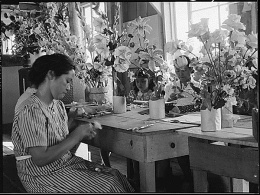 Media
Media
